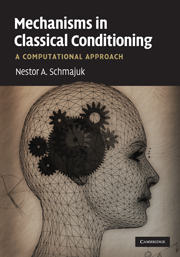Book contents
- Frontmatter
- Contents
- Preface
- Acknowledgments
- Abbreviations
- Part I Introduction
- Part II Attentional and associative mechanisms
- 2 An attentional–associative model of conditioning
- 3 Simple and compound conditioning
- 4 The neurobiology of fear conditioning
- 5 Latent inhibition
- 6 The neurobiology of latent inhibition
- 7 Creativity
- 8 Overshadowing and blocking
- 9 Extinction
- 10 The neurobiology of extinction
- Part III Configural mechanisms
- Part IV Attentional, associative, configural and timing mechanisms
- Part V Conclusion: mechanisms of classical conditioning
- References
- Author Index
- Subject Index
2 - An attentional–associative model of conditioning
from Part II - Attentional and associative mechanisms
Published online by Cambridge University Press: 23 May 2010
- Frontmatter
- Contents
- Preface
- Acknowledgments
- Abbreviations
- Part I Introduction
- Part II Attentional and associative mechanisms
- 2 An attentional–associative model of conditioning
- 3 Simple and compound conditioning
- 4 The neurobiology of fear conditioning
- 5 Latent inhibition
- 6 The neurobiology of latent inhibition
- 7 Creativity
- 8 Overshadowing and blocking
- 9 Extinction
- 10 The neurobiology of extinction
- Part III Configural mechanisms
- Part IV Attentional, associative, configural and timing mechanisms
- Part V Conclusion: mechanisms of classical conditioning
- References
- Author Index
- Subject Index
Summary
Schmajuk, Lam and Gray (SLG, 1996; Schmajuk & Larrauri, 2006) proposed a neural network model of classical conditioning. The SLG model shares properties with other associative models described in Chapter 1, including equations that portray behavior on a moment-to-moment basis (Grossberg, 1975; Wagner, 1981), the attentional control of the formation of CS–US associations (Pearce & Hall, 1980), the competition among CSs to become associated with the US (Rescorla & Wagner, 1972) or other CSs (Schmajuk & Moore, 1988) and the combination of attention and competition (Wagner, 1979).
Important properties of the SLG model include that (a) it describes not only CS–US associations, as in the above-mentioned models, but also the formation and combination of CS–CS and CS–US associations; (b) attention to the CS is controlled by the CS–US associations (as in the Pearce & Hall, 1980, model), by context–CS (CX–CS) associations (as in the Wagner, 1979, model), and by CS–CS associations (as in the Schmajuk & Moore, 1988, model; a property that explains why latent inhibition can become context independent – see Chapter 5); and (c) retrieval of CS–US and CS–CS associations is controlled by the magnitude of the attention to the CS (as in Wagner's, 1981, SOP model).
Information
- Type
- Chapter
- Information
- Mechanisms in Classical ConditioningA Computational Approach, pp. 21 - 33Publisher: Cambridge University PressPrint publication year: 2010
